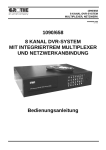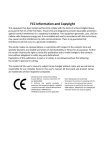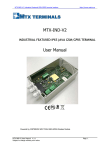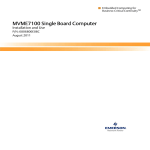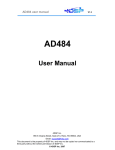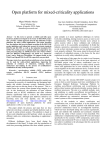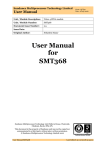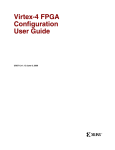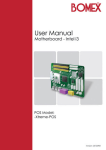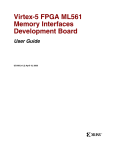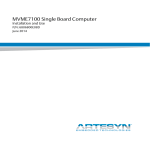Download User Manual - Sundance Multiprocessor Technology Ltd.
Transcript
Sundance Multiprocessor Technology Limited User Manual Unit / Module Description: User Manual Unit / Module Number: SMT348 Document Issue Number: 1.0.4 Issue Date: 06/11/2006 Original Author: E.P Form : QCF42 Date : 6 July 2006 User Manual Sundance Multiprocessor Technology Ltd, Chiltern House, Waterside, Chesham, Bucks. HP5 1PS. This document is the property of Sundance and may not be copied nor communicated to a third party without prior written permission. © Sundance Multiprocessor Technology Limited 2006 User Manual SMT348 Last Edited: 07/03/2011 15:41 Revision History Issue Changes Made Date Initials 1.0.0 First release 06/11/06 E.P 1.0.1 Minor inconsistency about comports removed from block Diagram 26/02/07 E.P 1.0.2 Clarification about the elements in the JTAG chain 15/11/07 E.P 1.0.3 Updated JTAG header information. Wrong marking of position. 29/02/08 E.P 07/03/11 S.M. Added chapters about bitstream formatting, FPGA configuration 1.0.4 Corrected: External Clock I/O (J1) - MMBX User Manual SMT348 Page 2 of 29 Last Edited: 07/03/2011 15:41 Table of Contents 1 Introduction ........................................................................................................................ 6 2 Related Documents........................................................................................................... 7 2.1 Referenced Documents ................................................................................................ 7 2.2 Applicable Documents ................................................................................................. 7 3 Acronyms, Abbreviations and Definitions................................................................ 8 3.1 Acronyms and Abbreviations ..................................................................................... 8 3.2 Definitions....................................................................................................................... 8 4 Functional Description .................................................................................................... 9 4.1 Block Diagram ................................................................................................................ 9 4.2 Module Description.....................................................................................................10 4.2.1 FPGA ..........................................................................................................................10 4.2.2 CPLD ..........................................................................................................................10 4.2.3 FLASH MEMORY ......................................................................................................10 4.2.4 JTAG Header ............................................................................................................10 4.2.5 FPGA Configuration schemes ..............................................................................11 4.2.6 FPGA Reset Scheme................................................................................................12 4.2.7 FPGA Bitstream formatting ..................................................................................13 4.2.8 QDR2 SRAM .............................................................................................................14 4.2.9 Sundance High speed Bus.....................................................................................15 4.2.10Sundance Low voltage Bus ...................................................................................15 4.2.11TIM Connectors.......................................................................................................16 4.2.12DIP Switches.............................................................................................................16 4.2.13Clocking scheme .....................................................................................................17 4.2.14LEDs ...........................................................................................................................17 4.2.15Performance.............................................................................................................17 4.3 Interface Description ..................................................................................................17 4.3.1 Power Budget...........................................................................................................17 5 Footprint ............................................................................................................................22 5.1 Top View........................................................................................................................22 5.2 Bottom View..................................................................................................................23 6 7 Pinout..................................................................................................................................24 6.1 FPGA Pin allocation by bank .....................................................................................24 6.2 SHB..................................................................................................................................24 6.3 SLB...................................................................................................................................24 6.4 JTAG ...............................................................................................................................25 Qualification Requirements .........................................................................................25 User Manual SMT348 Page 3 of 29 Last Edited: 07/03/2011 15:41 7.1 Qualification Tests ......................................................................................................25 7.1.1 Meet Sundance standard specifications ............................................................25 7.1.2 Speed qualification tests.......................................................................................26 7.1.3 Integration qualification tests .............................................................................26 8 Support Packages ............................................................................................................26 9 Physical Properties .........................................................................................................27 10 Safety ..................................................................................................................................28 11 EMC......................................................................................................................................29 User Manual SMT348 Page 4 of 29 Last Edited: 07/03/2011 15:41 Table of Figures Figure 1: Block Diagram.............................................................................................................. 9 Figure 2: CPLD state machine..................................................................................................13 Figure 3: FPGA connections to Bank1 of QDRII...................................................................14 Figure 4: Top View .....................................................................................................................22 Figure 5: Bottom view................................................................................................................23 Figure 6: JTAG Connector, top view.......................................................................................25 Table of Tables Table 1: DIP switch SW1 position for special reset feature..............................................16 Table 2: DIP switch SW1 position for the selection of the configuration bitstream source ...................................................................................................................................16 Table 3: DIP switch SW1 position for the selection of the Flash erase & program operations............................................................................................................................16 Table 4: Total available power. ...............................................................................................18 Table 5: Power budget on 1.2v ................................................................................................18 Table 6: Power budget on 2.5v ................................................................................................18 Table 7: Power budget on 1.8v. ...............................................................................................19 Table 8: Power budget on QDRII 0.9v Termination voltage. ............................................19 Table 9: Power budget on QDRII and FPGA 0.9v reference voltage................................20 Table 10: Power budget on 3.3v..............................................................................................20 Table 11: Coolrunner II resources summary. ......................................................................21 Table 12:Coolrunner II pin resources....................................................................................21 Table 13: Pin allocation by Bank.............................................................................................24 User Manual SMT348 Page 5 of 29 Last Edited: 07/03/2011 15:41 1 Introduction The SMT348 is an FPGA TIM module designed to be integrated in modular systems. It is designed to connect to the huge range of other TIM modules and carriers developed by Sundance. Sundance modular solutions provide flexible and upgradeable systems. The SMT348 is a TIM module aimed at completing the range of Sundance Virtex4 modules like SMT368 , SMT362 , SMT339 . HTU UTH HTU UTH HTU UTH It provides a communications platform between an XC4VSX55 or XC4VLX160 FPGA and • 4 banks of QDR2 SRAM at a frequency of up to 250Mhz. • 2 32-bit SHBs. • TIM Global Bus. • LVDS connections for high speed parallel connections • LVTTL connections and connectors. This variety of connectors and interfaces provides a wide range of development options for designers to explore the capabilities of the comprehensive Sundance TIM modules family. User Manual SMT348 Page 6 of 29 Last Edited: 07/03/2011 15:41 2 Related Documents 2.1 Referenced Documents HTU HTU HTU HTU HTU SUNDANCE SDB specification. SUNDANCE SHB specification SUNDANCE SLB specification Samsung QDRII Datasheet UTH UTH UTH UTH Spansion S29GLXXXN flash UTH 2.2 Applicable Documents HTU HTU HTU TI TIM specification & user’s guide . UTH Samtec QSH Catalogue page UTH Virtex 4 Datasheet User Manual SMT348 UTH Last Edited: 07/03/2011 15:41 3 Acronyms, Abbreviations and Definitions 3.1 Acronyms and Abbreviations TIM Texas Instruments Module TI© DSP Texas Instrument Digital Signal Processor Xilinx© FPGA Xilinx© Field Programmable Gate Array. QDR Quad Data Rate CP ComPort. Communication interface SDB Sundance Digital Bus. Communication interface SHB Sundance High-Speed Bus. Communication interface 3.2 Definitions DSP Module Typically a TIM module hosting a TI DSP and, a Xilinx FPGA. FPGA-only Module A TIM with no on-board DSP, where the FPGA provides all functionality. Firmware A proprietary FPGA design providing some sort of functionality. Sundance Firmware is the firmware running in an FPGA of a DSP module. User Manual SMT348 Last Edited: 07/03/2011 15:41 4 Functional Description This module conforms to the TIM standard (Texas Instrument Module, See TI TIM specification & user’s guide ) for single width modules. HTU U TH It sits on a carrier board. The carrier board provides power (5V, 3.3V, +/-12V), ground, communication links (Comport links) between all the modules fitted and a pathway to the host, for a non stand-alone system. The SMT348 requires a 3.3V power supply (as present on all Sundance TIM carrier boards), which must be provided by the two diagonally opposite mounting holes. 4.1 Block Diagram JTAG Header JTAG Flash memory Xilinx Coolrunner II CPLD XC2C256VQ100 on Comport3 and Config&control 4 banks of QDR2 SRAM 4x (2Mx18) Interrupts & Reset 5 I/O pins 2x ComPorts/SDL 24 I/O pins J1 Top Primary TIM Connector ComPort/SDL 0 & 3 JTAG 11 I/O pins 260 I/O pins FPGA 80 I/O pins Virtex-4 FF1148 XC4VSX55/LX160 1.5V Core 1.8V/2.5V/3.3V I/O 20 differential pairs 40 TTL IOs J2 Bottom Secondary TIM Connector ComPort/SDL 1 & 4 Add, Data, Control 72 I/O pins 2x ComPort/SDL 24 I/O pins 4 LEDs and Sundance High-speed Bus (2 Conn.) Sundance Low-voltage Bus (1 Conn.) ONLY with LX160 External clock Local clock J3 Global Bus TIM Connector Figure 1: Block Diagram User Manual SMT348 Last Edited: 07/03/2011 15:41 4.2 Module Description • Block1 and Block6 Xilinx Virtex 4 XC4VSX55/LX160 and configuration scheme. • Block2: QDR2 SRAM memory. • Block3: IO connectors for general purpose or dedicated interfaces. • Block4: 50MHz or 200MHz local clocks, and external clock input. • Block5: LEDs for development and in-use monitoring and general purpose use. 4.2.1 FPGA Xilinx Virtex 4 XC4VSX55FF1148 or XC4VLX160FF1148 FPGA. This device is packaged in a 1148-pin BGA package. 4.2.2 CPLD Xilinx Coolrunner II device XC2C256-6CP132C . This device is packaged in a 132-ball BGA type package with a -6 speed grade. HTU UTH It can be used to configure the FGPA via Comport 3, or from a configuration stored in flash memory. The flash memory is programmed using the CPLD and data via the ComPort3. 4.2.3 FLASH MEMORY HTU S29GL256N11TFI01 is a 256Mbit flash from Spansion UTH It can be used to configure the FPGA at power up. Flash accessed using Comport3 via the CPLD. Flash programming selection via switch SW1 (See Table 3 ) X X Software Library Support available from Sundance. The code can run on Sundance DSP TIM or a Host. All the flash functionalities are available. 4.2.4 JTAG Header The JTAG header is compatible with Xilinx Parallel-IV cable signals. HTU UTH It supports code download (for the FPGA), FPGA configuration, Hardware and Software Debugging tools for the Virtex-4. T This cable connects the parallel port of an engineer's Workstation/PC to the JTAG chain of the SMT348 Module. All the Xilinx devices from block1 are chained and accessible via this JTAG header. User Manual SMT348 Page 10 of 29 Last Edited: 07/03/2011 15:41 4.2.5 FPGA Configuration schemes Different schemes are available to provide maximum flexibility in systems where the SMT348 is involved: The FPGA configuration bitstream source is • On Comport 3: The CPLD is connected to the Comport 3 link of the SMT348 TIM connector. (See block1). A switch is used to select Comport 3 as the link that will be used to receive the bitstream. The CPLD allows for FPGA configuration in slave SelectMAP mode. • Using the on-board Flash memory. The CPLD monitors the configuration data between the Flash and the FPGA. The FPGA configuration is operated in Slave SelectMap mode. A switch is used to select the Flash as the source for the configuration bitstream. • Using the on-board JTAG header and Xilinx JTAG programming tools. The JTAG header is a Parallel-IV Header. H22H22HTU UTH Note: Using JTAG to configure the FPGA bypasses the CPLD which controls configuration. The following section describes the CPLD role and the reset scheme used. As the CPLD is bypassed when JTAG is used to configure the FPGA, it is necessary to adopt one of the three following ways: • If your FPGA design does not implement comport3, o do not use the Reset signal generated by the CPLD but use the TIM reset signal as your design’s reset. You can use JTAG to configure your FPGA with your application and the design will reset and run everytime you issue a new TIM reset. • If your design implements comport3 o Set the switch to configure the FPGA from flash after reset. In this way a default bitstream being stored in flash will be loaded in the FPGA by the CPLD. In this manner the CPLD has gone trhough the cycle of configuring the FPGA and releases the reset (FPGAresetn) Then you can reconfigure the FPGA via JTAG with your application. o Set the switch to configure from comport 3. After reset, configure the FPGA via JTAG and provide an end key word on comport 3 to the CPLD so that it releases the Reset. (FPGAresetn). User Manual SMT348 Page 11 of 29 Last Edited: 07/03/2011 15:41 4.2.6 FPGA Reset Scheme The CPLD is connected to a TIM global Reset signal provided to the SMT348 via its primary TIM connector pin 30. (See TI TIM specification & User’s guide). 23H23H This signal goes to the CPLD and the FPGA. Nevertheless as a general rule for good practice, the FPGA should not use this reset but should use the reset signal generated by the CPLD. The CPLD provides another signal called FPGAResetn that offers a better Reset control over the FPGA. At power up or on reception of a low TIM global Reset pulse, the CPLD drives the FPGAResetn signal low and keeps it low. This is used to keep the FPGA design in reset. A new FPGA configuration bitstream can then be downloaded. When the ENDKEY has been received, the CPLD drives FPGAResetn high. Use FPGAResetn for the Global Reset signal of your FPGA designs. In this manner, you can control your FPGA design Reset activity and you will also avoid possible conflicts on ComPort 3 if your FPGA design implements it. (Comport3 is a communication resource shared by the CPLD and the FPGA. But only 1 entity is allowed to use it at a time). If you implement comport 3 in the FPGA you have to use Fpgaresetn generated by the CPLD, as the comport is shared between the two. The Reset control is operated by the CPLD line FPGAResetn. The following diagram shows the CPLD states after Reset. User Manual SMT348 Page 12 of 29 Last Edited: 07/03/2011 15:41 TIM Reset or TIM Config Fpgaresetn asserted INIT FPGA Configured and ENDKEY Received STARTKEY Received CONFIG IDLE FPGA Configured Fpgaresetn de-asserted and ENDKEY Received Figure 2: CPLD state machine 4.2.7 FPGA Bitstream formatting If you generated you FPGA bitstream using Diamond FPGA, you do not need any other handling. The .app file created can be used as is to configure the FPGA. If you used Xilinx ISE and created a .bit file, you need to use the Sundance executable “Getrawdata.exe” provided for free in the SMT6001 package. Please read the SMT6001 help file at chapter: “Saving FPGA configuration data to file”. The resulting file can be used as is to configure the FPGA. User Manual SMT348 Page 13 of 29 Last Edited: 07/03/2011 15:41 4.2.8 QDR2 SRAM Up to 4 Mbytes of QDR2 SRAM per bank. The memory is available as 4 independent banks. The QDR2 memory runs at 250MHz. Each bank is fully independent with separate address, control and data busses and arranged as follows: 2 VREF VTERM=VREF/2 K/Kn Ctrl QQ[15:0] QD[15:0] NC + QSA[19:0] QWn/QRn QK/QKn(output) CQ(input) 2 2 20 16 16 21 R = 50 Ohms Q 16 16 XC4V CQ n CQ C/Cn QDRII Bank x Addr D 2 1 R = 50 Ohms VTERM=VREF/2 Figure 3: FPGA connections to Bank1 of QDRII The devices used are Samsung K7R321884M . Alternative part numbers, fully compatible can be fitted depending on availability at time of order. HTU User Manual SMT348 UTH Page 14 of 29 Last Edited: 07/03/2011 15:41 4.2.9 Sundance High speed Bus 2 x 60 pin connectors provide 80 IO connections between the FPGA and the outside word. They allow interfacing to other Sundance modules providing that you implement an SHB interface in the FPGA. (See 2.1 ) X X The SHB interface is available in Sundance SMT6500 support package. Either two 16-bit, or 1 32-bit interface can be implemented per connector. They allow interfacing to the outside world by implementing your own interface in the FPGA. The FPGA IO banks hosting the SHB signals are powered using Vcco = 3.3V. 4.2.10 Sundance Low voltage Bus This bus is present on the LX160 version of the module only. This is an LVDS bus comprising data (2 x 16 bit buses, I & Q), clock, and control signals. They allow interfacing to Sundance mezzanine modules providing that you implement an SLB interface in the FPGA. (See 2.1 ) X X They allow interfacing to the outside world by implementing your own LVDS interface in the FPGA. All LVDS data pins (both I and Q) are connected to a 2.5/3.3V powered FPGA banks (link selectable by jumper JP3). The FPGA LVDS DIFF_TERM standard should be used instead of the DCI terminations when LVDS standard is selected. DCI terminations are only available when a 2.5v standard is selected. The LVDS Clock signals are also in these banks. All LVTTL signals are connected to a 3.3V powered FPGA bank. User Manual SMT348 Page 15 of 29 Last Edited: 07/03/2011 15:41 4.2.11 TIM Connectors TIM connectors provide 4 communication links (Comports) and a Global Bus to the FPGA. The comports which are available on the SMT348 are CP0, CP1, CP3, and CP4. They allow interfacing to Sundance TIM modules or to a Host PC providing that you implement a Comport Interface inside the FPGA. (See 2.1 ) X X The Comport interface is available in Sundance SMT6500 support package. The FPGA io banks hosting the Comport signals are powered using Vcco = 3.3v. The TIM connectors also provide power/ground, reset and various control signals. References and specifications for these connectors are available in TI TIM specification & user’s guide HTU UTH 4.2.12 DIP Switches One four-position DIP switch is connected to the CPLD to provide control over the selection of the configuration bitstream source and a special reset feature called “TIM Confign”. SW1 pos 4 TIM Config ON ENABLED OFF DISABLED Table 1: DIP switch SW1 position for special reset feature SW1 pos 3,2, 1 JPC3 JPC2 JPC1 C3P OFF OFF OFF Flash OFF OFF ON Table 2: DIP switch SW1 position for the selection of the configuration bitstream source SW1 pos 3,2, 1 JPC3 JPC2 JPC1 Flash accesses ON OFF OFF Table 3: DIP switch SW1 position for the selection of the Flash erase & program operations. The Flash erase & program operations are operated by the CPLD. Commands are provided via Comport3 from an application running on a Host or DSP. Status information from the Flash is given over Comport3 as well. User Manual SMT348 Page 16 of 29 Last Edited: 07/03/2011 15:41 4.2.13 Clocking scheme The SMT348 module contains a 50MHz LVTTL clock, a 200MHz clock, and a connector for an external LVTTL clock input/output. 50 MHz LVTTL oscillator: Main system clock. Clocks the CPLD and the FPGA. Can be input in a DCM. 200MHz LVTTL oscillator: QDRII clock. Can also be used as a main FPGA clock. Can be input in a DCM. An external clock input is provided to the Virtex 4 FPGA via an MMBX connector. This connector is NOT fitted by default or if a mezzanine is required. YOU MUST ask Sundance if needed for your application. 4.2.14 LEDs 4 Red LEDs connect to the FPGA and are available to the User: D4, D5, D6, D7. 1 Green Led: D1, connects to the DONE pin of the FPGA and is lit to show that the FPGA is configured. (depending on supply from manufacturer a red led can be fitted instead). 4.2.15 Performance The FPGA features like speed grade and density dictate most performances. The performances achievable by the other components are given in the chapters above and the components respective data sheets. 4.3 Interface Description For the TIM to carrier board or external world interfacing, see in Sundance Help file (that you can download from the Sundance Wizzard) HTU UTH 4.3.1 Power Budget The SMT348 draws its power from the 3.3v rail of the PCI. The PCI specification stipulates that the maximum power for one card is 25W. Therefore, the maximum current that the SMT348 could draw from +3.3V is 7.6A, assuming zero current on all the other supply voltages. But this limit is "system dependent," so a given system might not have the full 7.6A available for a slot even if it is the only PCI card in the system. A system might balance the power capabilities differently between the +5V and +3.3V (and +/12V) supplies, rather than making 25W available from +5V and 25W available from +3.3V. User Manual SMT348 Page 17 of 29 Last Edited: 07/03/2011 15:41 As a result, check your main power supply ratings. If your system is likely to reach 25W per power rail we advice that you provide extra power to the carrier board using an external power supply. Device Name Quantity Voltage(V) Current(mA) Power(W) 3.3v power supply V33 1 3.3 7600 25 Source HTU PCI specifications U TH Table 4: Total available power. Device Nam e Quantit y Voltage(V) Curren t(mA) Power(W) XC4VLX160FF1148-11 Vccint=1.2v Vfpg a 1 1.2 1.805 2.166 Fpga Vccint power plane capacity Vfpg a Source Virtex-4 power estimator HTU (design implementation of 4 independent qdrii controllers) 1 1.2 14000 16.8 UTH TI TPS50410 HTU UTH Table 5: Power budget on 1.2v Device Name Quantity Voltage(V) Current(mA) Power(W) XC4VLX160FF114811 Vcco=2.5v (LVDS TX pairs on SLB bus) V25 40 2.5 10 1 XC4VLX160FF114811 Vcco=2.5v (LVCMOS TX on SLB bus) V25 Total power consumed V25 Fpga 2.5v power plane capacity V25 Source Virtex-4 power estimator HTU UTH 27 2.5 12 0.81 Virtex 4 ds302 v1.17 p.7 HTU UTH 1.81 1 2.5 Excess power 1.5 3.75 LT1963-1.5A Linear Regulator 3.3v to 2.5v/1.5A HTU 1.94 Table 6: Power budget on 2.5v User Manual SMT348 Page 18 of 29 Last Edited: 07/03/2011 15:41 UTH Device Name Quantity Voltag e(V) Current(m A) Power(W) Samsung QDR II burst 4 (18-bit interface) V18 4 1.8 800 5.76 ML6554CU DC/DC converter V18 Source Samsung QDRII (25), datasheet rev1.1 p.9 HTU UTH 1 1.8 0.01 0.018 Fairchild ML6554CU (obsolete) HTU UTH Coolrunner XC2C256CP132 V18 1 1.8 0.55 0.00099 XC4VLX160FF114811 HSTL II V18 1 1.8 829 1.497 Total power consumed V18 HSTL power plane (1.8v) capacity V18 Ise 8.2.03i Xpower software version: I.34 Virtex-4 power estimator HTU (design implementation of 4 independent qdrii controllers) UTH 7.27599 1 1.8 6000 Excess power 10.8 HTU TI TPS54611PWP UTH 3.525 Table 7: Power budget on 1.8v. Device Nam e Quantit y Voltage(V ) Current(m A) Power(W) QDRII Vtt termination resistor (50 ohms) (See details) V09 240 0.9 18.0 3.89 Total power consumed V09 HSTL Vtt termination Power Plane (0.9v) capacity V09 Source Samsung QDRII (-25), datasheet rev1.1 p.9 HTU UTH 3.89 1 0.9 3000 5.76 Fairchild ML6554CU (obsolete) HTU UTH Excess power 1.87 Table 8: Power budget on QDRII 0.9v Termination voltage. User Manual SMT348 Page 19 of 29 Last Edited: 07/03/2011 15:41 Device Name Quantity Voltage(V) Current(mA) Power(W) QDRII Vref VR09 8 0.9 0 0 Source Samsung QDRII (-25), datasheet rev1.1 p.9 HTU UTH XC4VLX160FF1148-11 HSTL Vref VR09 Total power consumed VR09 HSTL Vref plane (0.9v) capacity VR09 16 0.9 0.01 0.000144 DS302 (v1.17) table 3 p.3 HTU UTH 0.000144 1 0.9 3 0.0027 Fairchild ML6554CU (obsolete) HTU UTH Excess power 0.002556 Table 9: Power budget on QDRII and FPGA 0.9v reference voltage. Device Name Quantity Voltage(V) Current(mA) Power(W) 25 Mhz Clock oscillator V33 1 3.3 15 0.05 Source Jauch VX3 Quartz crystal oscillators datasheet HTU UTH 200 Mhz Clock oscillator V33 1 3.3 20 0.066 Jauch VX3 Quartz crystal oscillators datasheet HTU UTH Linear Regulator 3.3v to 2.5v/1.5A V33 1 3.3 1.136 3.75 DC/DC converter 3.3v to 0.9v V33 13.75 N/A DC/DC converter 3.3v to 1.2v V33 14000 N/A DC/DC converter 3.3v to 1.8v V33 6000 N/A DIP Switch V33 1 3.3 0.7 0.002 Flash memory V33 1 3.3 90 0.297 XC4VLX160FF114811 LVTTL Vcco=3.3v V33 1 3.3 3.3v power plane V33 HTU LT1963-1.5A Fairchild ML6554CU (obsolete) HTU UTH 1 3.3 Depends on implemented design 7600 25W HTU HTU TI TPS50410 UTH TI TPS54611PWP UTH Four 4.7 Kohm pullup HTU S29GL256N UTH Virtex-4 power estimator HTU UTH HTU TI TPS50410 Table 10: Power budget on 3.3v. User Manual SMT348 UTH Page 20 of 29 Last Edited: 07/03/2011 15:41 UTH Details: Coolrunner XC2C256-6-CP132 power requirements based on design: Function Block Inputs Used 218/256 (86%) 531/896 (60%) 190/256 (75%) 69/106 (66%) 445/640 (70%) Macrocells Used Pterms Used Registers Used Pins Used Table 11: Coolrunner II resources summary. Signal Type Required Input 8 Output 40 Bidirectional 20 GCK 1 GTS 0 GSR 0 Mapped 8 40 20 1 0 0 Pin Type I/O GCK/IO GTS/IO GSR/IO CDR/IO DGE/IO Used 65 3 0 1 0 0 Total 96 3 4 1 1 1 Table 12:Coolrunner II pin resources. User Manual SMT348 Last Edited: 07/03/2011 15:41 5 Footprint 5.1 Top View Figure 4: Top View User Manual SMT348 Last Edited: 07/03/2011 15:41 5.2 Bottom View Figure 5: Bottom view User Manual SMT348 Last Edited: 07/03/2011 15:41 6 Pinout 6.1 FPGA Pin allocation by bank Bank I/O Vr* 1 2 48 48 0 0 3 16 0 4 16 0 5 64 4 6 64 4 7 64 6 8 64 6 9 64 4 10 64 4 11 12 64 64 6 6 13 64 6 14 64 6 QDR2 SHB CP SLB GB Other Total 8xConfig 8 Clocks & DLL control 2 Clocks & Reset & Switches Bank C Data + Control Bank B Data + Control 13 64 64 SLB LVTTL Bank D Data & Control Bank A Data & Control PXI, TTL, 13 Control INTs, LEDs, 64 Misc. 32 Data & 64 31 Address & 1 Control 64 64 1xSHB 1xSHB 2xCP 2xCP 64 64 16 Diff Data & 4 Diff Clocks 16 Diff Data & 4 Diff Clocks 46 46 Vr* = Vrp + Vrn + Vref Table 13: Pin allocation by Bank 6.2 SHB HTU SUNDANCE SHB specification UTH 6.3 SLB HTU SUNDANCE SLB specification User Manual SMT348 UTH Last Edited: 07/03/2011 15:41 6.4 JTAG TDO 4 TCK 3 TDI 5 GND 2 TMS 6 3.3V 1 JP1 Figure 6: JTAG Connector, top view 7 Qualification Requirements 7.1 Qualification Tests 7.1.1 Meet Sundance standard specifications • Meet the TIM standard specifications • Meet the SLB specifications (LVDS standard). • Meet the SHB specifications. User Manual SMT348 Last Edited: 07/03/2011 15:41 7.1.2 Speed qualification tests • QDR2 memory accesses at 250MHz. 7.1.3 Integration qualification tests • Must work on ALL Sundance platforms as a root TIM module or as part of a network of TIMs on carriers. • Must be able to work stand-alone. 8 Support Packages User Manual SMT348 Page 26 of 29 Last Edited: 07/03/2011 15:41 9 Physical Properties Dimensions Weight Supply Voltages Supply Current +12V +5V +3.3V -5V -12V MTBF User Manual SMT348 Last Edited: 07/03/2011 15:41 10 Safety This module presents no hazard to the user when in normal use. User Manual SMT348 Page 28 of 29 Last Edited: 07/03/2011 15:41 11 EMC This module is designed to operate from within an enclosed host system, which is build to provide EMC shielding. Operation within the EU EMC guidelines is not guaranteed unless it is installed within an adequate host system. This module is protected from damage by fast voltage transients originating from outside the host system which may be introduced through the output cables. Short circuiting any output to ground does not cause the host PC system to lock up or reboot. User Manual SMT348 Last Edited: 07/03/2011 15:41






























